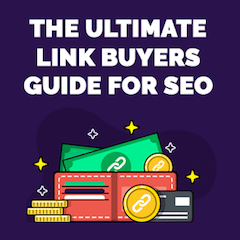 This is a complete guide to buying backlinks in 2022.
This is a complete guide to buying backlinks in 2022.
If you buy backlinks – or are thinking to – then stop what you’re doing and read this post to the end.
I’m about to pull back the curtain and tell you everything you need to know about paid backlinks from if (and when) they’re safe, to how to go about buying SEO backlinks should you decide to.
I’m covering:
- What exactly is backlink buying?
- Google’s stance on link buying
- Different link attributes (and which is Google safe)
- A brief history of link buying
- Why people buy backlinks
- How much backlinks cost
- Four ways to pay for links
- How to buy backlinks the right way
- And, much more!
Let’s jump right in.
How does your website score? Get a free instant audit that will uncover the biggest SEO issues affecting your site, and how to fix them.
What Exactly is Backlink Buying?
Buying backlinks is the process of paying for a link back to your site from another website.
Usually, the goal of a link buyer when purchasing backlinks is to increase the ranking of their own website within search engines.
Other objectives “could” be to increase referral traffic or generate conversions – but it’s far less common.
Do people buy backlinks? Absolutely!
Backlinks are a valuable commodity because the weight of backlinks pointing to a website is a primary search engine ranking factor, especially for Google.
In simple terms, the more relevant and quality links you have to point to your website – the higher you can rank in search engine results pages.
This is the basis of Google’s PageRank algorithm:
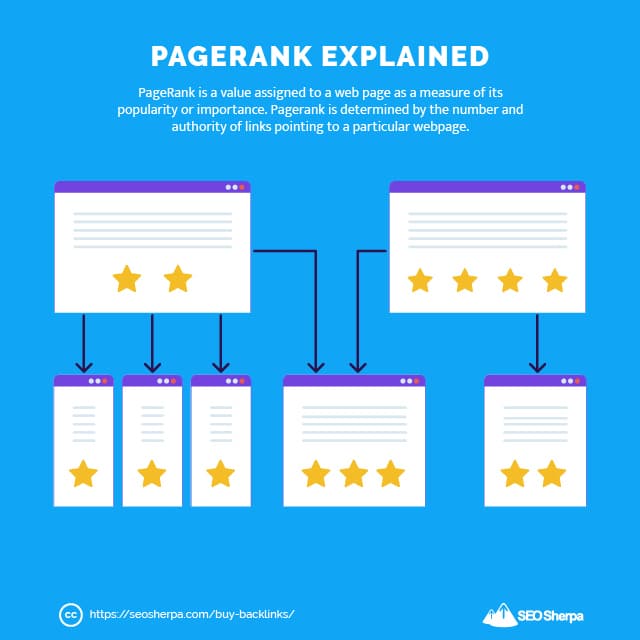
Higher rankings in search engines mean more website visitors, and ultimately more sales and profits.
All of which makes the acquisition of backlinks incredibly valuable – particularly for commercial entities.
Buying links can come in various forms:
- Paid guest posts
- Paid link insertions
- Private Blog Networks (PBNs)
- Paid directory listings
- Press release distribution services
Typically, paid links are purchased for money.
However, an exchange of money, goods, or services with the intent of acquiring a backlink is considered by Google as a “paid link.”
Buying Backlinks: Google’s Stance on Link Buying
Most SEOs will tell you that Google is explicitly against paid links.
They’re not!
Infact, Google points out that paid links are a “normal part of the economy of the web.”

What Google is in opposition to is buying links for the specific purpose of passing PageRank.
In other words, buying (or selling) links to manipulate search engine rankings.
This is what Google calls a Link Scheme:

There are numerous types of links that violate Google’s Webmaster Guidelines.
Here are the main ones:
- Excessive link exchanges. In other words; “I’ll link to you if you link to me.”
- Large-scale article marketing or guest posting campaigns with keyword-rich anchor text links.
- Using automated programs to create links that point to your site.
- Requiring a link as part of a Terms of Service, or contractual arrangement.
- Exchanging money, goods or services for a link that passes PageRank.
On the other hand, links purchased for advertising purposes are perfectly OK as far as Google is concerned.
Assuming that is, they carry the “rel=nofollow” or “rel=sponsored” attributes.
What are Nofollow and Sponsored Link Attributes?
The “rel=” attributes nofollow and sponsored provide contextual hints to search engines:
- rel=”nofollow”: Informs search engines the link was created merely as a reference, and that the author of the link does not endorse the website being linked to.
- rel=“sponsored”: Informs search engines the link was created as part of an advertising or sponsorship arrangement and no endorsement is inferred.
Here is what these two link types look like in code:
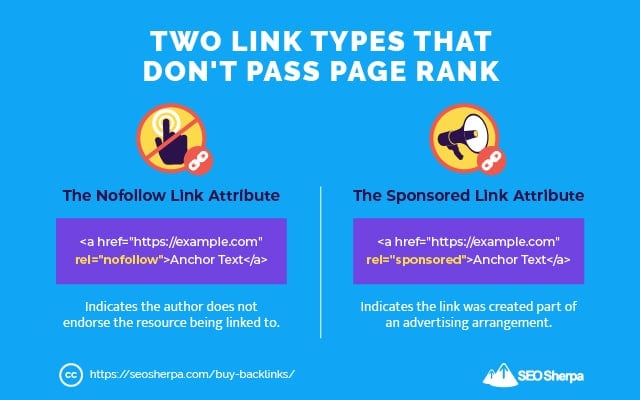
Neither a “rel=nofollow” nor a “rel=sponsored” link passes authority onto the website it is linking to.
Which means:
Buying links that carry these attributes abide by Google’s Webmaster guidelines entirely.
The trouble is, however, rel=nofollow and rel=sponsored links do not typically carry much (if any) value for SEO.
Does that mean these links are devoid of value? Not at all.
In 2019, Google announced that it would treat nofollow links as hints rather than directives. In other words, Google will sometimes “count” a nofollow link (and sometimes it won’t).
This is especially true for high-profile sites like Entrepreneur and Forbes, who apply “no-follow” to all outbound links by default.
Take this post I wrote for Entrepreneur.com, all the external links I added to that article have been no-followed:
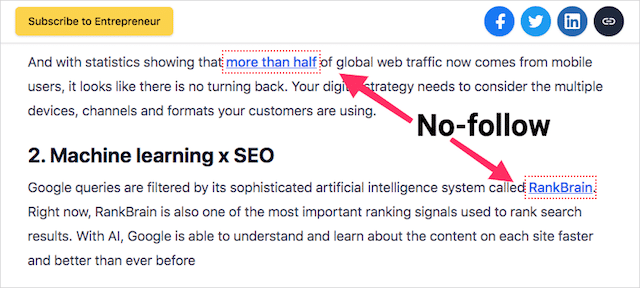
Given the authority of Entrepreneur as a website and its strict editorial guidelines – you can bet your bottom dollar Google is passing along some ranking credit to the pages I linked to.
On the other hand, followed links always pass ranking credit (e.g., PageRank) to the target webpage.
Follow Links: What are They?
A “follow” link is any backlink with no “rel=” marker attached to it.
In other words, a normal h-ref link without sponsored, no-follow, or user-generated content attributes.
Here is what a “follow” link looks like as HTML code:
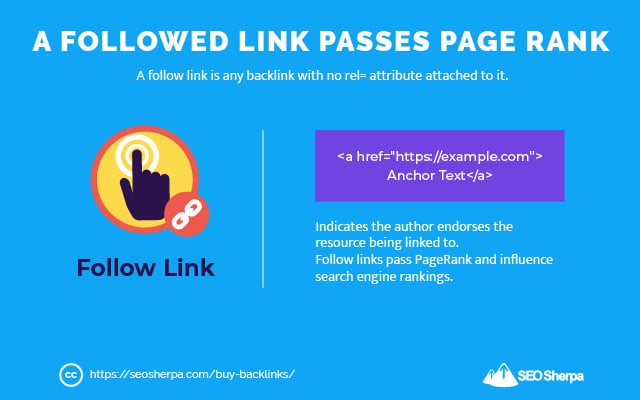
When there is no “rel=” attribute, Google considers the link as a signal of endorsement and passes PageRank to the linked-to page.
In other words, “follow” links pass ranking credit (AKA “link juice”) and positively influence SEO.
But, here’s the warning:
Buying “follow” links is against Google Webmaster Guidelines.
And, according to Google, websites that engage in buying links that manipulate PageRank can expect their ranking to be negatively affected:

With the looming threat of a ranking decline, surely no smart SEO would engage in backlink buying?
Think again:
A Brief History of Link Buying
When Google invented the PageRank algorithm it soon left the competition for dust.
Why?
The use of backlinks as the main component of their algorithm gave Google a HUGE competitive advantage:
Google could measure the popularity of a webpage better than anyone else.
The result was the best order and ranking of search results of any search engine out there – and users flocked to Google on mass.
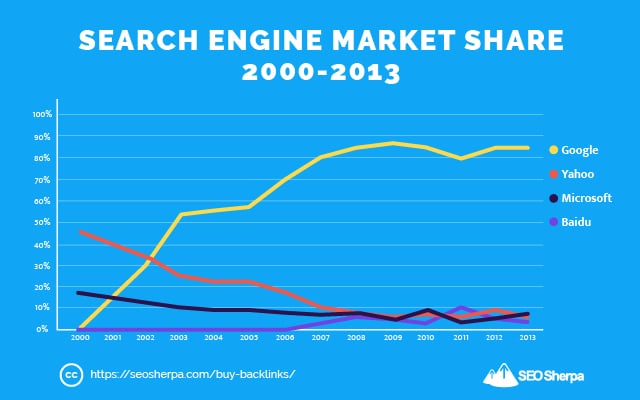
With the sheer volume of traffic, Google began to generate, SEO specialists set about identifying what made the algorithm tick.
It wasn’t long before the search engines’ use of backlinks became evident to folks in the SEO industry, and a massive market for buying and selling links emerged.
Early Backlink Buying: The Late 1990’s to mid-2000’s
If you’ve been in SEO as long as I have, you may recall the Yahoo directory.
Along with DMOZ, the Yahoo Directory was the creme de la creme of directory websites in the early to mid-2000s.
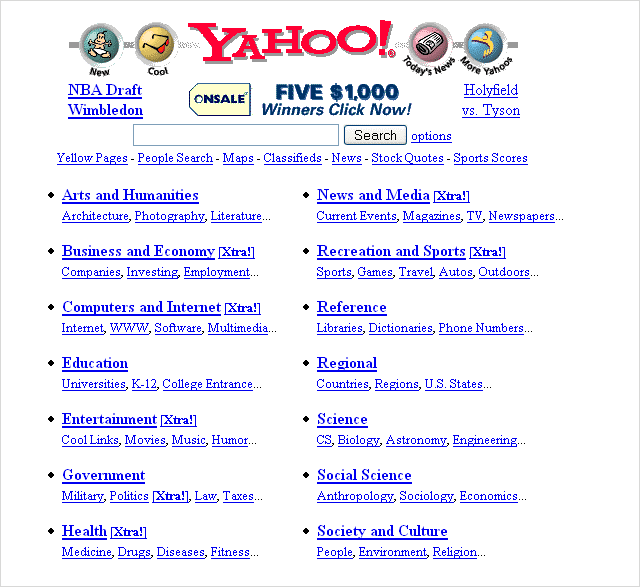
At the time the now-perished Yahoo Directory charged a fee of $299 for inclusion.
While some sites got rejected, as long as your business was legit, you were pretty much guaranteed a listing.
But let’s be clear, SEOs were not buying a listing on these websites for the branding or traffic benefit.
They were doing it for the link juice.
The Yahoo directory, and other paid directories like it, were some of the earliest examples of backlink buying for SEO.
The Link Buying Explosion (the Mid-2000s Onwards)
By the mid-2000s the paid link industry was booming.
Numerous link-building services had emerged to cater to the exploding demand for paid links.
Link buying services like Text Link Ads sold individual links on a “rental” basis.

Mostly, these links were site-wide sidebar or footer links. Prices started at $30 per month.
Other services included link building tools like SENuke and SEOLinkVine that blasted out spun articles to a large network of blogs:
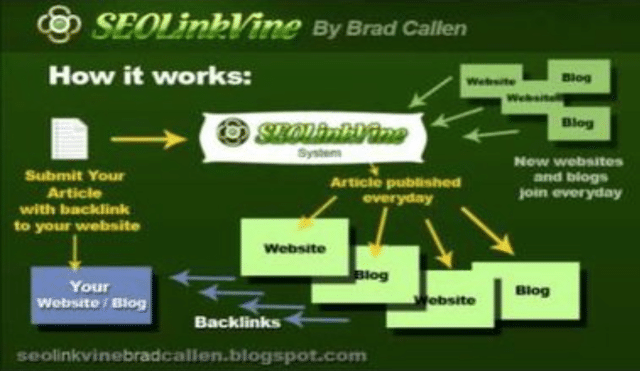
These link-building tools enabled users to build “unique” editorial links at scale for a fee as low as 97 bucks per month.
While the inventory of websites was often low-quality, at the time at least, tools like these were seriously effective.
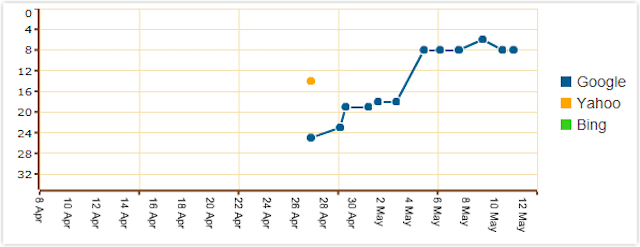
And so bought about, the Google crackdown on link buying.
The Rise and Fall of PBNs (the Late 2000s to 2012)
By the latter part of the decade, a large number of private blog networks (PBNs) had emerged.
These networks of blogs were created for one thing, and one thing only – building links that manipulate the PageRank algorithm.
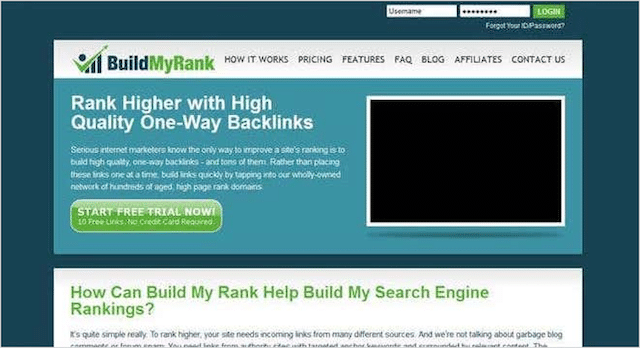
But wait, what exactly is a private blog network?
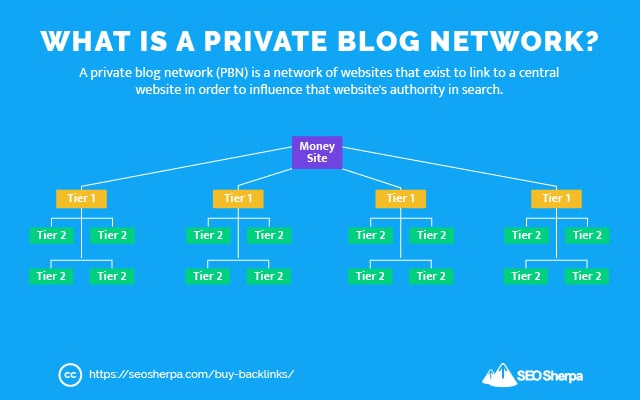
A private blog network is essentially a set of websites you use to link out from to improve the rankings of one or more domains.
Often these websites are populated with garbage content and receive little (if any) traffic.
In other words, they’re not genuine websites.
The PBN boom of the late 2000s came about because these “high-PR, low-quality” PBN links worked like crazy.
At the time, you could acquire a few dozen PBN backlinks pointing to an aged domain and your rankings would skyrocket in a matter of days – or even hours.
What’s more, it didn’t seem to matter if the PBN links were even relevant, or if the quality of the content was good. If the backlinks you bought had high PageRank, and you acquired enough of them – your target website could quite literally take over the SERPs.
Enter Google Penguin.
In early 2012 Google released the Penguin algorithm update.
The goal of Google Penguin was to crack down on link schemes and excessive (manipulative) link-building tactics.
Popular PBNs like BuildMyRank were slapped with penalties, and sites using PBN links dropped like a stone from SERPs.

While Google Penguin didn’t specifically target private blog networks, PBNs were amongst the biggest losers in this algorithm update.
Google’s Crack Down on Link Schemes (2012 to 2016)
Building on the first version of Penguin in 2012;
Over the next four years, Google released a series of updates that sought to further penalize websites for link spam techniques.
Beginning with Penguin 1.1 in May 2012, and culminating in Penguin 4.0 in September 2016, Google laboriously cracked down on paid links, gradually forcing link sellers underground.
Aside from algorithmic penalties, Google plowed increasingly more resources into their manual review team.
More and more penalties got handed out to those caught selling links:
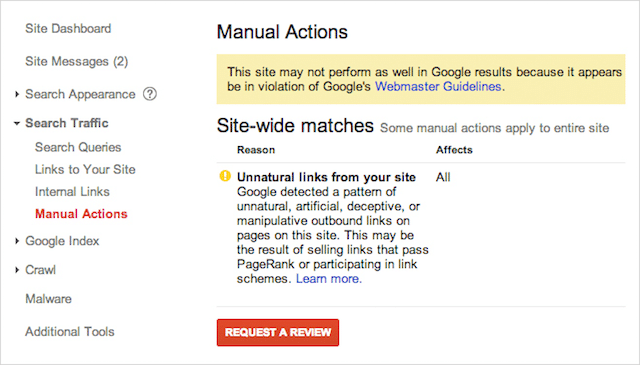
As well as to the buyers they sold to.
Sometimes penalties took the form of a PageRank loss, but in other cases, the result was a complete de-index from search results.
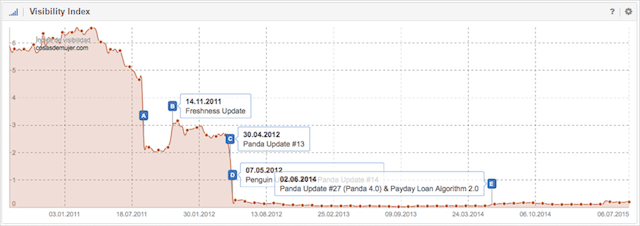
With such serious penalties getting handed out, did this kill off the link buying market?
Not in the slightest, but it did force a pivot:
Link Buying and Selling Today (and Beyond)
Many of the paid link-building tactics that worked in the past no longer work today.
Article marketing automation, private blog networks, site-wide text links…these once-popular link-building strategies have all seen better times.
The current link-building market is far more nuanced and obfuscated out of view.
Sure, blatant link selling still happens on sites like fiverr.com:
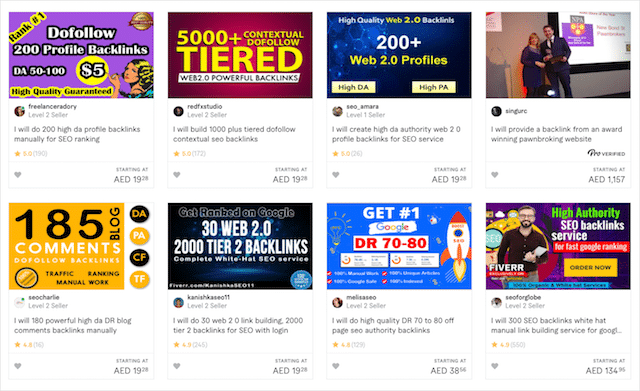
But, generally speaking, links that get bought and sold in this day and age are far less detectable by Google.
The most common paid links right now are paid guests posts (AKA “sponsored posts”) and link insertions, also known as “niche edits.”
Let’s break each one down:
Sponsored Posts
As the name suggests, a sponsored post is when you pay for a guest post on another website.
Those posts could be written by you, the site owner, or an intermediary vendor.
Sponsored posts rarely carry mention of sponsorship, use “rel=sponsored” link attributes, or hint the post is a paid guest post.
As such, they are often undetectable by Google.
Link Insertions
Link insertions are commonly referred to as niche edits.
This link-building tactic involves paying a site owner to edit their existing content with a link to your website.
Niche edits are popular because link buyers can acquire links on established web pages without the burden of creating content.
Why Do People Buy Backlinks?
Search marketers tend to buy backlinks for one of three reasons:
Time, money, or effectiveness.
Time
There’s no escaping it. Buying backlinks is far quicker and easier than the arduous task of creating content that acquires backlinks naturally.
If you’ve done organic outreach you’ll know it is a massive time-suck.
First, you need to create killer content assets that people want to link to. Second, you must research sites you can target, and third, write custom outreach emails (if you want a reply), and then manage replies and follow-ups.
This whole process can take weeks.
On the other hand, buying backlinks is relatively quick and pain-free.
Find a website willing to sell a link, agree on a price, get your link placed.
Money
Ironically, the price of paid links can be cheaper than “free” backlinks.
Let me explain:
To be effective at free link building, you need a lot of resources.
Let’s say you are doing free guest post link building. This strategy will require you to produce high-value content, and that will demand skilled content writers, graphic artists, and subject matter experts.
You’ll also need a team to perform outreach and subscriptions to link-building tools if you want to win links at scale.
The cost of free link building can work out to be higher than paying someone to do this for you.
Effectiveness
Let’s be real. Contrary to what Google might tell you:
Buying backlinks works!
What’s more:
When done properly, there’s practically no risk of a penalty because it’s impossible for Google to distinguish what’s a paid placement and what’s not.
If you are going to buy links, you only want to work with bloggers and site owners who have high standards, such as:
- They never advertise they sell links anywhere it can be found. Because of that it would be very hard for Google to ever identify your link has been paid for.
- They only sell links to relevant sites within the same niche to maintain a natural outbound link profile.
- They space out the placement of paid outbound links with natural editorial links making paid links even less detectable.
- They maintain the highest content quality and very often create the content themselves to ensure a consistent tone of voice.
In other words, they behave just like a quality domain with 100% natural links.
And, keep the business of selling links hidden out of sight.
Buying Backlinks? How Much Do Backlinks Cost?
The raw price of paid backlinks can vary ALOT!
The type of link is a factor, the industry is a factor, the site’s Domain Rating or Domain Authority is a factor.
In a study of 450 websites conducted by Ahrefs, they found that of all websites charging for backlinks, the price of link insertions ranged from as little as $50 to as much as $2,500 (no kidding)!
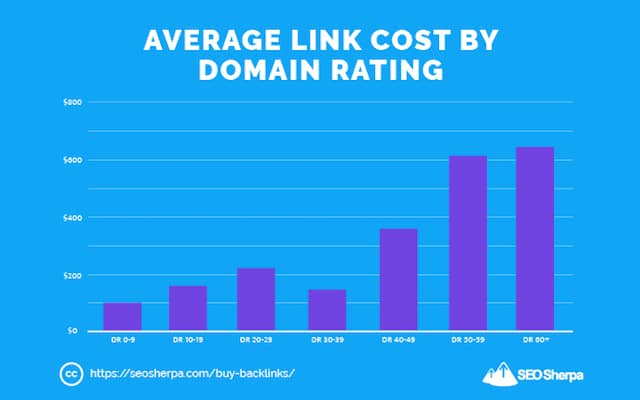
The price of guest posts started at $15 and went up to $300.
Compare that Ahrefs study to the prices charged by a typical link vendor, and you’ll see the prices are pretty similar:
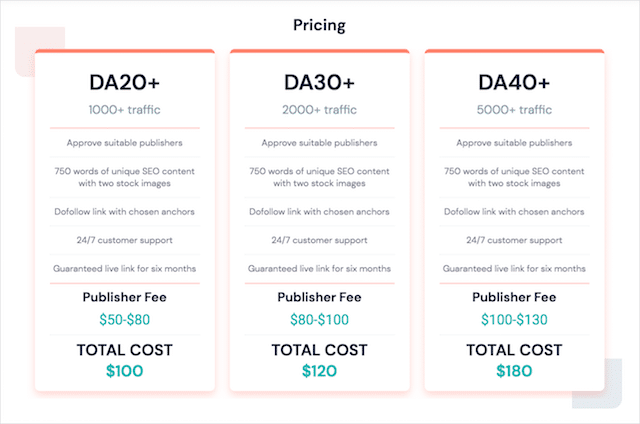
But, the cold-hard price of the link is not your only “cost.”
The Main Four Ways To “Buy” Links (And Which Is Right For You)
Don’t get suckered into thinking that link buying ONLY occurs when you pay a website owner with cash.
Any investment in link building costs either time or money – and usually both.
With that in mind, let’s break down the four main ways you can pay for backlinks so you can determine which one is right for you (if any).
In-House Link Buying
Unless you are a seasoned pro who is super serious about link building, this is not where I’d recommend you start.
Doing link building in-house requires a HUGE investment of time, energy, resources, and learning.
First, you’ll need to hire the right people. Even if you start with a small remote team (I’d suggest an outreach manager and a content writer) you are looking at $60,000 per year in just staff.
Second, you’ll need some tools. At the cheaper end, you could probably get by with Ahrefs Lite plan and Mailshake. These two together would set you back $807 per year.
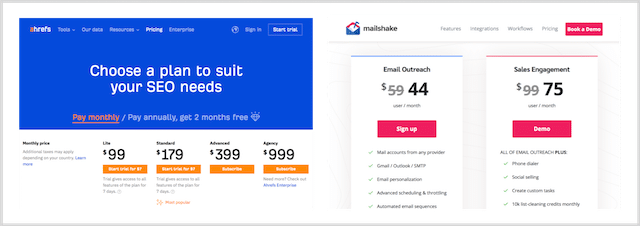
Third, you’ll need to equip your team with relevant link-building training. If you’d like a suggestion, this course by Brian Dean is one I can vouch for.
Add to that, any other general costs that come with staffing – like perks and medical cover – and you might easily add another $5,000 to your expenses annually.
So, in summary:
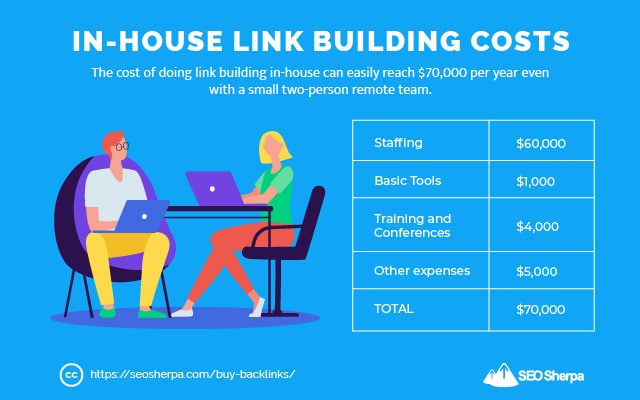
If you decide to go in-house with your link building, even if you never “pay” for a backlink, you are still in the hole for $70,000 per annum.
That’s no pocket change!
Agency Link Buying
If you choose to engage an agency to do your link building – you are by nature paying for backlinks.
How much your pay, however, depends on the number and quality of links they build for you, and the SEO company you work with.
Credible link building services can charge anything from $2,000 to $10,000 per month – and upwards of $20,000 monthly for enterprise solutions:
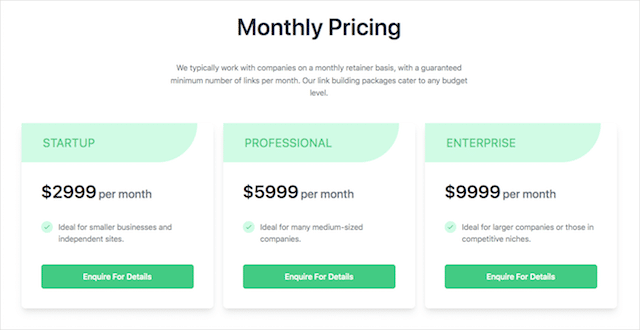
On average, agency link building is going to be lower cost than in-house, especially at lesser link volumes.
(A starting point of $24,000 per year compared to $70,000 in-house)
Plus, it has four key advantages over doing link-building in-house:
- You access established processes on day one, meaning you’ll acquire links sooner and faster
- You outsource the headaches of hiring, training and managing to someone else – more peace of mind for you!
- You pay a fixed monthly retainer which is better for budgeting and provides you with certainty over the outcome (e.g., “for $5,000 per month I’m certain of 10 quality backlinks”)
- You can start and stop at short notice (typically with 30-90 days in writing)
Engaging an SEO agency to do your link building is a very good option for most businesses.
Private Link Buying
If you’ve ever performed outreach and gotten a response like this:
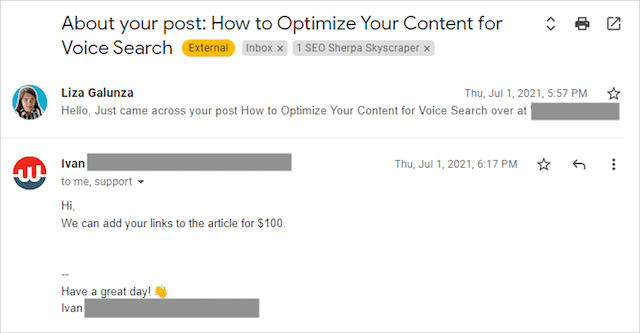
Then you just hit up a private link seller.
In most cases, the blogger or website owner won’t openly advertise that backlinks can be bought from them.
(Most “selling” is done in private via their email inbox)
But…
If they do sell backlinks, then they are by definition a backlink vendor.
At SEO Sherpa, we do a helluva lot of link-building outreach for clients – and our own website – and we get asked to pay for links a lot!
In our experience, the prices asked by private link sellers can vary massively.
In the past year, the most expensive link we got pitched was $8,000 from a website in the travel niche.
The lowest-priced link we got pitched was $15 from a general interest website.
Most private link sellers asked between $100 and $200 for a link on their site which is consistent with Ahrefs study.
But remember, the cost of the link itself is not your only expense.
First, there is the cost of the outreach. A half-decent outreach specialist should be able to find, negotiate and get one live link placed for every two hours of work.
Let’s assume a moderate SEO consultant’s rate of $134.14, that’s an additional $268 expense per link.
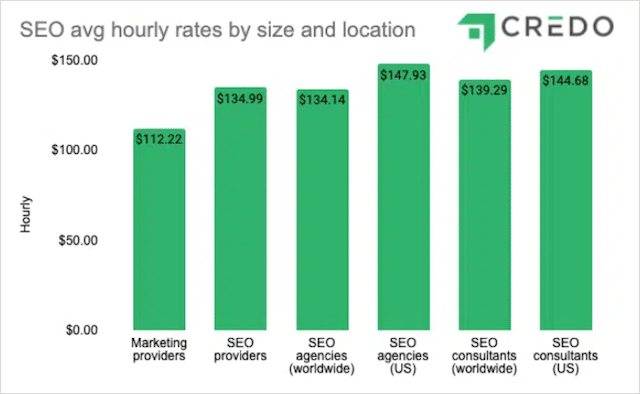
And, if you need to create content, you’ll be adding even more to your cost.
- Link cost = $150
- Outreach cost = $134
- Content cost = $100
- TOTAL = $384
As you can see, the cost of private link buying soon adds up.
The advantages of private link buying are that you can get links live quickly, and there is no long-term commitment to an agency retainer or a team of in-house staff.
The disadvantages are that it requires an investment of time and money – and there is an element of risk.
After all, you could get caught!
Middleman Link Buying
If you want to save some time – and reduce your risk, then you could consider buying backlinks from a marketplace.
Link building marketplaces sandwich themselves between the website selling backlinks and the end-user (e.g. you) buying the backlinks.
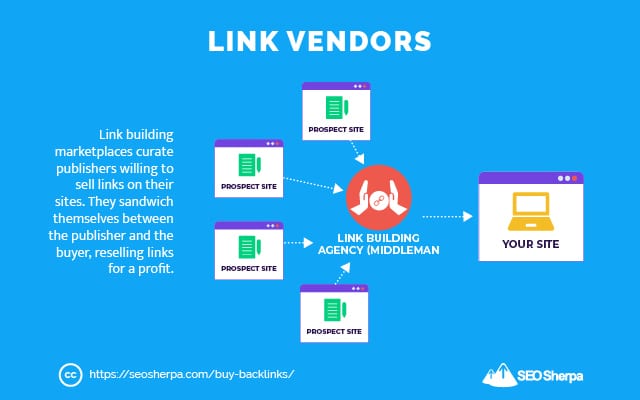
Using a middleman marketplace requires a fraction of the time needed for direct blogger outreach.
Instead of manually searching for niche relevant websites, sorting and filtering opportunities based on SEO value, finding email addresses, personalizing and sending hundreds of individual pitches, and writing content…
You could simply send one email to an account manager who sources and places the link on your behalf.
How it works:
Middleman link vendors cultivate relationships with thousands of publishers.
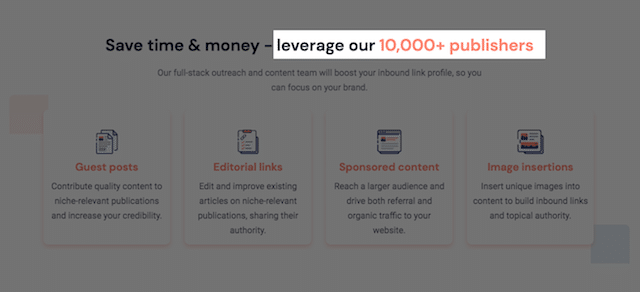
They do this by offering free content to bloggers and website owners (or even paying them) for the ability to link out from that content to a handful of customer websites.
They do this at scale across multiple verticals.
Then compile those sites into curated lists from which you the link buyer can choose.
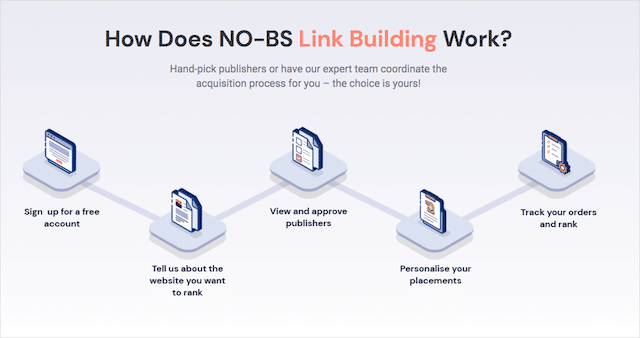
Think of these services like a giant Rolodex of blogs.
Therein lies the value:
By using a middleman link vendor, you access an on-demand portfolio of websites sorted by niche and domain authority, without the headaches associated with finding the websites yourself.
As for costs?
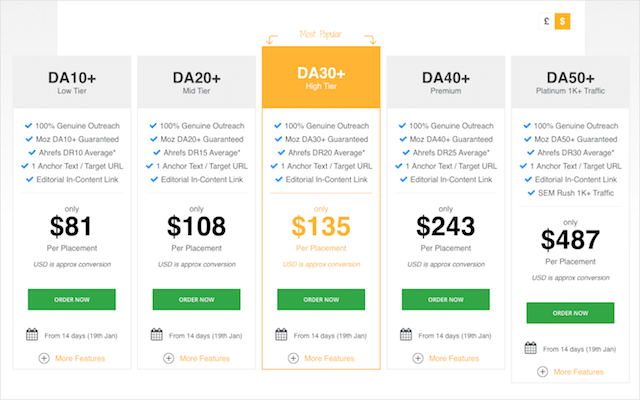
You can expect to pay anything from $100 to $250 for a single quality link with decent Domain Authority.
Which, with all things considered is (probably) less than expensive if you were doing it yourself.
How to Buy Backlinks (The Right Way)!
In a moment I’m going to show you how to buy backlinks, safely and effectively at scale – step-by-step.
But first:
If you are considering buying backlinks, let’s get clear about what you should not do:
(1). Don’t buy backlinks from fiverr.com, UpWork, Freelancer, or any other low-cost gig websites. The price is cheap for a reason. Links sold through websites like this are almost always toxic link spam that does more harm than good.
(2). Don’t buy backlinks from any form of link networks such as private blog networks (PBNs), or any website publicly selling links. If they can detect them, Google slaps these types of paid links real hard.
(3). Don’t buy backlinks from any vendor that pitches you over LinkedIn or Gmail with an “authority blogs” list. Not even if they look like Harry Potter:
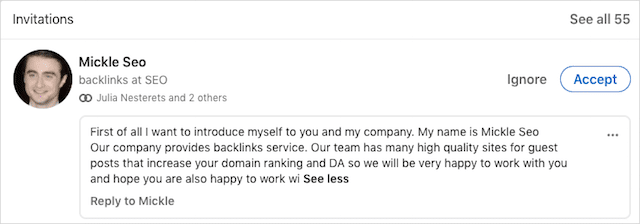
The potential risk posed by these link-building wizards is far greater than any possible reward.
With that cleared up, lets now cover how to buy backlinks the right way:
The Foolproof Process for Buying Backlinks “Safely”
Any form of link buying (for the purpose of manipulating PageRank) has some degree of risk.
However:
If you do your proper due diligence, you can mitigate that risk almost entirely.
So, what makes a paid link safe?
Basically, any backlink, that “appears” natural to users and search robots.
In other words:
- It’s on a “legit” website or blog and not part of a vendor network or PBN
- The website has no mention of selling links ANYWHERE Google could find it
- The website is valued by search engines. A good site should rank for hundreds of keywords and generate 1,000+ visits per month
- The website and page should be relevant to the target URL you are linking to
- The site should be in a reputable neighborhood. In other words it should have links to (and from) authoritative sites in your niche, and definitely no pills, **** or ******** links.
- The website should contain valuable content – and not content produced solely for SEO purposes
If you are going to buy backlinks – have the time and money to do so – finding and negotiating placements yourself is (in my opinion) worth the extra effort.
By securing your own opportunities, you’re guaranteeing the links you purchase are on high-quality sites that not only build link equity but drive traffic and awareness.
Not only that, you’ll uncover a tonne of untapped link opportunities the middle man link vendors (and your competitors) are yet to discover.
With that out the way, let’s break down the process:
Method 1: Find and Pitch Sites Accepting Advertisements
The simplest way to find squeaky clean backlinks to buy is to identify websites that actively accept advertising.
Websites like this make money from selling space on their site, which makes them a damn easy pitch.
You can find sites accepting advertisements by using a range of advanced search operators.
Here are a few that work great:
- “advertise on our site” + keyword
- “advertise on this site” + keyword
- “advertise” + keyword
- “partnership opportunities” + keyword
Focus your keyword modifier on terms related to your business, such as your niche:
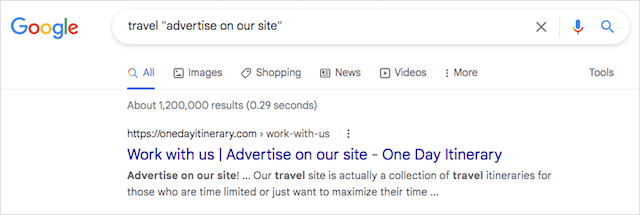
Or your geography:
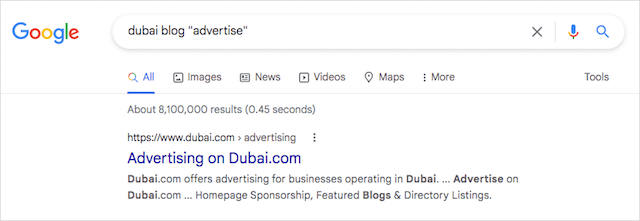
Try multiple search operators and keyword combinations to build a list of potential targets.
Then, remove any websites that do not fit this criterion:
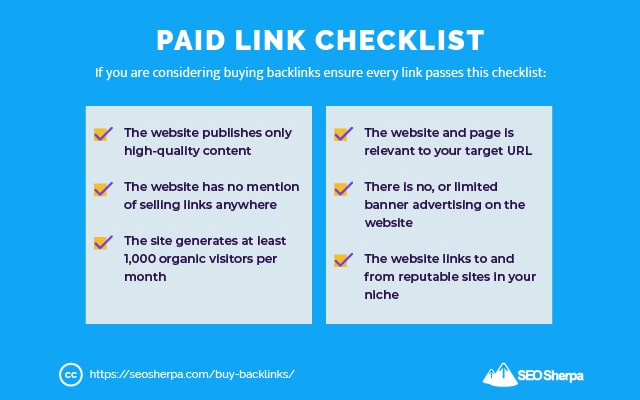
Now, it’s time to make your pitch.
The key is to explain that you’re looking for a sponsored post, and not a newsletter insertion, banner ad, or any other form of traditional advertisement.
Here’s how your pitch might look:
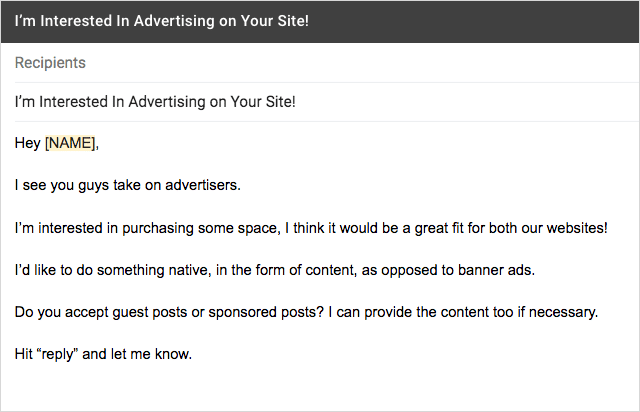
Since many of the sites you target won’t have sold links before, be sure to stipulate these two points:
- The post should not be marked with sponsored, or advertorial etc.
- The lins in the article should be followed and not “rel=sponsored” or “rel=nofollow”

If the target cannot agree to these two terms, then move on to other targets.
Method 2: Blogger Partnerships
This second method works like gangbusters.
Why?
Because, a few hundred bucks to add a link into their content, is a lot of money for a blogger.
Most don’t get paid to write and will snatch your hand off for that kind of money and two minutes of work.
To find bloggers to target try these search operators:
- “blogs” + keyword
- “bloggers” + keyword
- “blog” + keyword
- “updates” + keyword
- inurl:blog + keyword
- intitle:blog + keyword
You can also, search for “Best Blogs” lists:
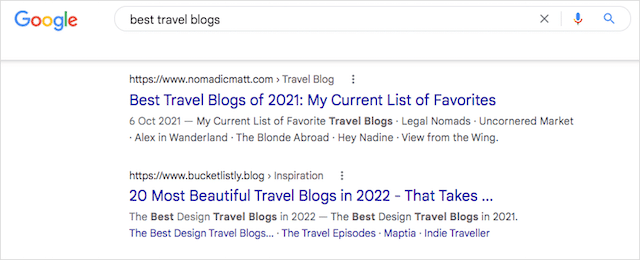
This tactic alone will uncover hundreds of opportunities in most niches.
Once you’ve filtered your list and found each blogger’s contact details, then you make your pitch.
For this method, you are seeking a link in an existing piece of content.
Most bloggers aren’t going to accept guest content (the notable ones at least).
Plus, getting existing content updated is actually better for you:
- You dont’t have the expense of writing content
- You can land links on already authoritaive pages
This is what a pitch might look like:
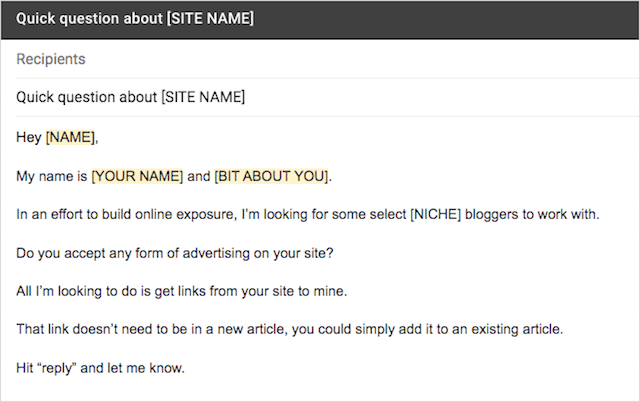
If you’re going to buy backlinks – that’s how you can do it (relatively) safely.
Over to You
I hope you found this link buyers guide useful.
Buying backlinks is definitely something you should do cautiously. But, there’s no escaping it, if done properly it really can work.
The only question is: Is it worth the risk to pay for backlinks?
Tell me what you think:
What’s your #1 takeaway from this post? Are you more, or less likely to buy backlinks after reading this guide?
Or maybe you have a question. Leave me a comment below, and I’ll answer it for you.
